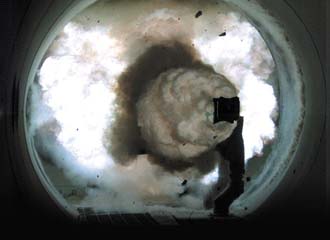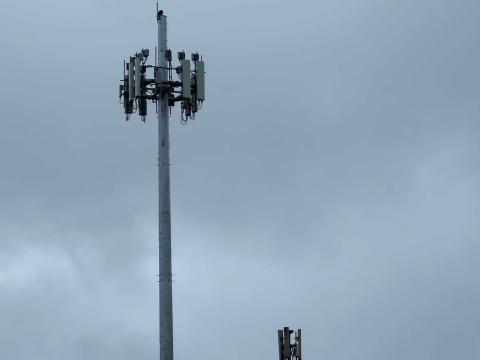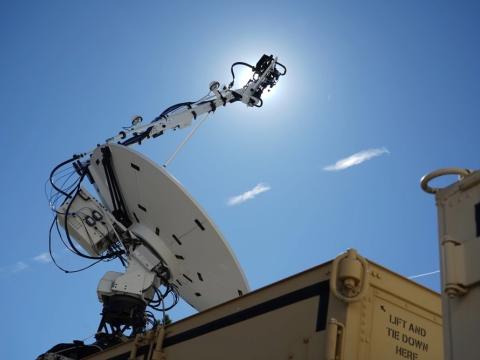Sea Power Becomes Electric
 |
An electromagnetic railgun developed by the Office of Naval Research (ONR) pumps 33 megajoules of energy to fire a projectile at several times the speed of sound. The ONR is working on new power systems that would enable surface warships to carry railguns capable of hitting targets more than 200 nautical miles distant. |
Scientists working for the U.S. Navy are exploring a raft of new energy technologies designed both to wean the sea service off its reliance on traditional fossil fuels and to provide new sources of power for ships that will require ever greater amounts of electricity.
This research touches on both the evolutionary and the revolutionary. Navy scientists are striving to advance the state of the art in existing disciplines, such as fuel cells and alternative energy sources, that could be applied to future sea and air craft. Similarly, they also are pursuing new technology breakthroughs that could provide game-changing capabilities to the fleet.
Capt. Robert Palisin, USN, deputy department head for the sea warfare and weapons department at the Office of Naval Research (ONR), explains that the navy’s energy research focuses on two principal priorities: increasing energy security and increasing energy independence. This two-pronged thrust translates into more efficient power sources and better energy storage systems.
The Navy is conducting this diverse research across the full spectrum of its research community. Coordination among these elements is growing. “We definitely have a rapidly rising focus on this issue,” the captain offers. “Energy security and independence are becoming key parts of what we do in the Navy and the Marine Corps, as well as inside ONR.”
These efforts are being conducted concurrently across research lines. The Navy has a new future naval capability, or FNC, for power and energy. Implemented this year, that FNC is a central node within ONR for communication and coordination among the research elements. This extends to the user community as well, Capt. Palisin relates.
The captain states that being able to create long-term, steady-state power will enable the Navy to store power for use in upcoming pulse radars and weapons systems such as lasers and railguns. The expanding use of information systems mandates increased bandwidth and more electrical capacity. Subsequent generations of ships will have fewer crew members relative to their progenitors, as technology assumes more roles traditionally held by humans. This includes the growing use of unmanned systems, Capt. Palisin points out.
The Navy is conducting its electronics research with future platforms in mind, and this effort involves trying to anticipate what those platforms will comprise in terms of systems and capabilities. “As we require our platforms to become more dependent on the flow of electrons, we must ensure that the energy is reliable and created cost effectively,” he emphasizes.
Capt. Palisin reports that researchers are working on improvements in distribution and control systems. “If you go through the full spectrum of things associated with the power cycle—power generation, storage, distribution control and ultimately power loads—improving efficiencies there [is the target of] a multitude of different efforts that will all contribute to reducing overall energy requirements of the future Navy and, ultimately, reducing or even removing our dependence on fossil fuels,” he states.
Fuel cells are high on the Navy’s research list. Unmanned air and underwater vehicles would be the first beneficiaries of improved fuel cell technology. Sharon Beermann-Curtin, ONR program officer, notes that the Navy works closely with the Department of Energy on fuel cell development. Research continues into several different types, particularly for materials to improve fuel cell efficiency, she notes. These include solid oxide fuel cells that can use propane or other low-sulfur liquid fuels, for example.
In addition to unmanned platforms, crewed ships also will be incorporating fuel cell technology to varying degrees. Capt. Palisin expresses the hope that the Navy can expand and improve fuel cell technology to the point where it would serve a major role aboard some smaller ships. This would take place in the more distant future, perhaps 15 to 20 years down the line, he suggests.
Navy scientists also are focusing on storage systems that can hold energy without much of the loss that occurs in today’s systems. This effort begins with new types of batteries that store energy more efficiently, and it also includes innovative materials that both store and transfer energy more effectively.
Beermann-Curtin points out that this relates directly to alternative energy research. Exploiting solar and wind technologies requires energy storage, as those two capabilities are not always available on demand for power generation.
She continues that the Navy is conducting research into capacitors and flywheels as well as batteries. Issues such as load and time constants figure into which storage technology the Navy may need at a given time during operations.
 |
U.S. Marines in the field can draw power from a 300-volt photovoltaic battery array developed by the ONR. Energy and power are major focal points for ONR research efforts for Navy land, sea, undersea and air systems. |
One area of research that offers significant potential is silicon carbide switches. Beermann-Curtin explains that existing converters and power switches use silicon semiconductors, but silicon carbide offers a more rugged semiconductor that can be fabricated thinner than its conventional silicon counterparts. This allows a switch to operate more quickly, which reduces transformer size in higher frequencies. This in turn enables better electricity control for more efficient movement of power to different systems, she points out.
Another application for silicon carbide is electrical power distribution. Ships today use alternating current (AC) for power distribution, Beermann-Curtin points out. However, a ship that can move its electricity through a medium-voltage direct current (DC) architecture can control its energy flow more effectively. The ONR is looking at silicon carbide switches, along with power converters and modeling and simulation tools to help build a DC electrical architecture, she says, adding that this technology could be a game changer.
Having a DC power architecture also will help enable better use of photovoltaic technologies. Beermann-Curtin relates that the Navy constantly strives for better photovoltaic efficiencies for its mobile environment. Lighter weight and flexible constructs also are research goals, especially for Navy and Marine Corps forces on the ground. Marines already are using solar blankets in the field, she points out, and the potential is far-reaching. Shore-based facilities are beginning to adopt them.
Many of these electric power advances are necessary because of electrical systems that will be coming on line in the foreseeable future. For years, the Navy has been developing an electric railgun that will fire projectiles at high speeds without the use of rockets or explosive projection. Ultimately, it could replace conventional guns aboard ships. The captain describes the railgun’s function as “completing the cycle of power generation to power use as efficiently as possible.” But, it will require high amounts of pulsed energy, and it must be able to sustain a rate of fire over a long period of time to be an effective ship-based weapon. So, its development must be conducted in parallel with that of high-energy power sources and distribution systems.
“If you want all of these high-technology solutions that provide better capabilities, it always seems that they take more power,” Beermann-Curtin points out. “The need for power will continue to grow. That’s why we have to come up with better materials and be smart about how we distribute out power through the system.
“The game changing will be [that we] have a very efficient energy system that can reliably power up these new systems,” she explains.
Among ship propulsion systems, Navy research is exploring technologies that are more energy efficient and flexible in terms of consumption. Some research focuses on future propulsion technologies, but for the foreseeable future the fleet will be using traditional means of propulsion such as gas turbines and nuclear power, Capt. Palisin reports.
Alternative fuels, such as biodiesel (SIGNAL Magazine, July 2010) already are making their mark, and research continues into further advances and other non-fossil fuel technologies. The Navy is not seeking to develop new fuels, Beermann-Curtin explains, but instead seeks to ensure that it can exploit them effectively.
Future Navy ships may have hybrid propulsion systems similar to those found in some of today’s automobiles. “Scale those technologies up to ship levels of power, and that [technology] is exactly what would make those propulsion systems far more efficient,” Capt. Palisin posits. “The same kind of savings that you have shifting from an old Toyota Corolla to a Toyota Prius are the same kinds of efficiencies and improvements that we would expect to see [in Navy ships],” he adds.
Another way of improving ship propulsion efficiency is to reduce drive friction. Researchers are working to develop nano ceramic coatings and lightweight structural materials. Beermann-Curtin explains that these nano ceramic materials will extend the life of ship components as well as reduce energy consumption. The materials are corrosion-resistant and have better thermal performance standards as well.
Capt. Palisin offers that if these energy research efforts bear fruit and the Navy is able to implement their advances into the force, the result will be more flexible platforms that are fuel efficient—potentially using only nonfossil fuels. Ships will have more capabilities, including laser and railgun weapons along with instantaneously networked systems that can ensure the entire fleet operates as a single unit.
The captain cautions that, to be successful, the laboratory results must be translated into implementation. This will require both program will and funding.
WEB RESOURCE
Office of Naval Research: www.onr.navy.mil




Comments